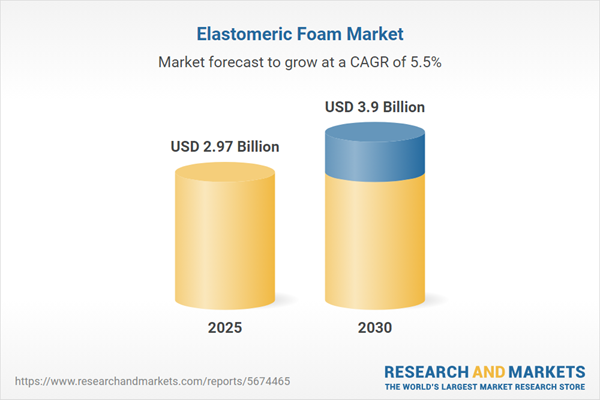Speak directly to the analyst to clarify any post sales queries you may have.
Senior executives searching for advanced materials to strengthen operational continuity and manage regulatory risk are turning their attention to elastomeric foam. This insulation technology aligns with ongoing demands for efficiency, reliability, and compliance across sectors experiencing tighter regulations and a growing need for asset resilience.
Elastomeric Foam Market Snapshot
The global elastomeric foam market is valued at USD 2.82 billion in 2024 and is expected to grow at a CAGR of 5.54% through 2030. This trajectory reflects strong demand from construction, automotive, electronics, and healthcare industries. Organizations are prioritizing material solutions that reduce risk and enhance sustainability, with infrastructure upgrades and optimized energy management driving adoption. In response to intensifying operational and compliance requirements, many businesses are reassessing their insulation strategies to support efficiency and resilience.
Scope & Segmentation of the Elastomeric Foam Market
- Elastomer Types: Chloroprene rubber, EPDM (ethylene-propylene-diene monomer), ethylene-vinyl acetate, nitrile rubber, polyacrylic rubber, and silicone rubber deliver specialized insulation, mechanical robustness, and strong chemical resistance for mission-critical applications.
- Forms: Sheets, rolls, and tubes facilitate comprehensive coverage and easy adaptation to complex installations, making integration seamless across facilities and equipment.
- Cell Structure: Closed-cell foams block moisture ingress and support energy savings in HVAC and refrigeration, while open-cell types optimize sound absorption and ergonomic comfort, particularly suited for packaging and interior environments.
- Applications: Elastomeric foam serves diverse needs, from thermal and acoustic insulation to equipment protection and tailored packaging, ensuring stable operations where reliability is essential.
- End-Use Industries: The material sees major uptake in automotive, construction, healthcare, electronics, and packaging, where enhanced safety, streamlined workflows, and improved compliance underpin process performance.
- Sales Channels: Buyers access elastomeric foam via direct sales, distributors, dealerships, and online platforms, which aligns purchasing with project needs and regulatory expectations.
- Regions: Adoption patterns differ by geography. The Americas, Europe, Middle East, Africa, and Asia-Pacific experience various drivers, such as local policy changes, infrastructure investments, and funding landscape variations.
- Key Companies: Leading providers include Armacell International S.A., Kaimann GmbH by Compagnie de Saint-Gobain S.A., and Zotefoams plc, each delivering innovation, agile supply networks, and support for compliance programs.
Key Takeaways for Senior Decision-Makers
- Elastomeric foam increases asset reliability. This minimizes unplanned downtime and simplifies maintenance in environments where operational continuity is critical.
- Adopting halogen-free and bio-based foam variants allows organizations to proactively address new environmental mandates and shift ahead of regulatory developments.
- Technological advances in fire safety and structural engineering strengthen elastomeric foam’s suitability across industries where safety standards are stringent.
- Developing regional sourcing strategies and local supplier partnerships helps prevent supply chain disruptions and supports alignment with unique regional regulatory frameworks.
- Integrating digital analytics in manufacturing boosts quality assurance and standardization, especially important for organizations operating across multiple sites or countries.
- Partnering with experienced suppliers accelerates strategic insulation projects, enabling a shift from reactive to proactive operational risk management.
Evaluating the Impact of Tariffs and Supply Chain Strategies
- Changes in tariff policies, notably in the United States, are leading organizations to review procurement processes to maintain cost control and reduce risk exposure.
- Companies governed by demanding compliance standards are strengthening supply dependability by sourcing elastomeric foam closer to operational sites and partnering with trusted local suppliers.
- Diversification of supply chains supports material consistency and helps buffer businesses from policy-driven disruptions or sudden market changes.
Methodology & Data Sources
Findings are based on direct interviews with senior industry stakeholders and end-users, alongside detailed reviews of sector-specific publications and regulatory guidelines. Robust analytical methods—including triangulation, SWOT analysis, and Porter’s Five Forces—have been used to provide actionable insights tailored for leaders in the elastomeric foam market.
Why This Report Matters: Actionable Insights for the Elastomeric Foam Market
- Senior leaders can leverage proven frameworks from this report to optimize sourcing, integrate new technologies, and reinforce compliance programs across operational regions.
- Comprehensive segmentation offers the ability to anticipate and mitigate organizational risk, with targeted strategies supporting diverse regional standards and complex operational needs.
- Supply chain guidance ensures that organizations maintain high quality and compliance, even as global industry demands and regulations continually shift.
Conclusion
Elastomeric foam enables enterprises to strengthen stability and address risk management proactively. Continued innovation and strategic provider relationships help organizations remain competitive and adaptive in changing regulatory and market conditions.
Additional Product Information:
- Purchase of this report includes 1 year online access with quarterly updates.
- This report can be updated on request. Please contact our Customer Experience team using the Ask a Question widget on our website.
Table of Contents
3. Executive Summary
4. Market Overview
7. Cumulative Impact of Artificial Intelligence 2025
Companies Mentioned
The companies profiled in this Elastomeric Foam market report include:- Armacell International S.A.
- Kaimann GmbH by Compagnie de Saint-Gobain S.A.
- Zotefoams PLC
- Sekisui Kasei Co., Ltd.
- Huntsman Corporation
- ODE Yalıtım A.Ş.
- Era Polymers Pty Ltd
- Hira Industries LLC
- NMC SA
- Aeroflex Company Limited
- Huamei Energy-saving Technology Group Co., Ltd
- UNION FOAM S.p.A.
- Durkee(Wuhan) Insulation Material Co., Ltd
- Kingflex Insulation Co., Ltd.
- The Supreme Industries Ltd.
- Insulflex Corporation Sdn Bhd
- ISIDEM Yalıtım A.Ş
- Evocell&Mobius Srl
- Rogers Foam Corporation
- Evonik Industries AG
- Secon Rubber and Plastics, Inc.
- L'Isolante K‑Flex S.p.A.
- The Gund Company
- The Dow Chemical Company
- ISOPIPE S.A
- Goveco
Table Information
| Report Attribute | Details |
|---|---|
| No. of Pages | 195 |
| Published | November 2025 |
| Forecast Period | 2025 - 2030 |
| Estimated Market Value ( USD | $ 2.97 Billion |
| Forecasted Market Value ( USD | $ 3.9 Billion |
| Compound Annual Growth Rate | 5.5% |
| Regions Covered | Global |
| No. of Companies Mentioned | 27 |









